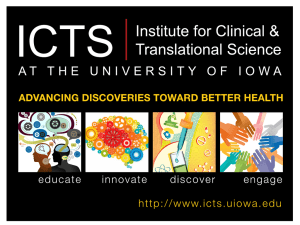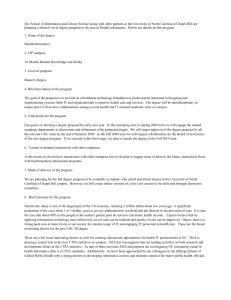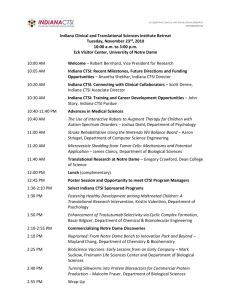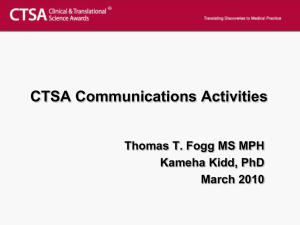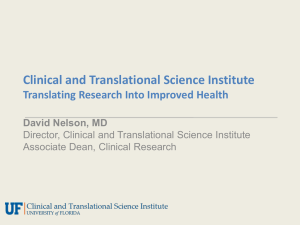FrameWorx_November2015_CTSI
advertisement
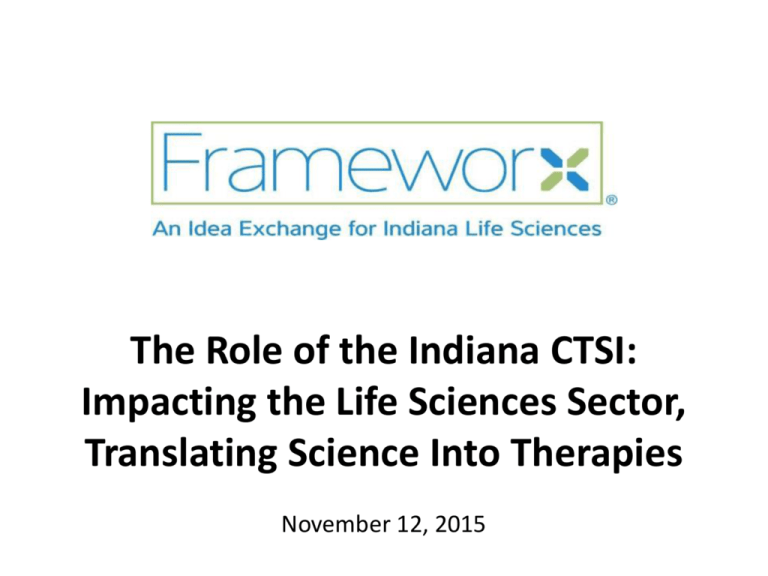
The Role of the Indiana CTSI: Impacting the Life Sciences Sector, Translating Science Into Therapies November 12, 2015 Chris Eckerle, Project Director, BioCrossroads Thank You Official Printer for Frameworx The Role of the Indiana CTSI: Impacting the Life Sciences Sector, Translating Science Into Therapies November 12, 2015 Indiana’s Position in the Past, Present & Future November 12, 2015 Evolution of the Translational Science at NIH 1960 1970 2004 National Institutes of Health (NIH) develops vision to foster patient-oriented research (POR) and creates 5-year renewable competitive grants for the establishment of General Clinical Research Centers (GCRCs). 5 funded sites. NIH awarded equal number of research project grants to MD, MD-PhD and PhD scientists. By 2005: 7000 grants to PhDs; 3000 to MD and MD PhDs combined. GCRCs described by Congress as “critical” infrastructure for POR. GCRCs expected to be a driving force behind future biomedical research. 80 GCRCs. 2005 Implementation of the NIH Roadmap and efforts to revitalize clinical and translational research lead to phasing out of GCRC program. Funding consolidated and redirected to launch CTSA program. 2006 Following the first round of awards, NIH added between 5-14 new sites each year until the program reached level of 62 sites nationwide in 31 states and the District of Columbia. 2012 NCRR dissolved, and National Center for Advancing Translational Science (NCATS) founded. Evolution of NIH CTSA 2004: The NIH Roadmap 2005: Conceiving the Program 2007: Anticipating the New Era CTSA Today NCATS Mission To catalyze the generation of innovative methods and technologies that will enhance the development, testing and implementation of diagnostics and therapeutics across a wide range of human diseases and conditions. Some of the scientific translational problems on NCATS’ to-do list ► Predictive toxicology ► Predictive efficacy ► Derisking undruggable targets/untreatable diseases ► Data interoperability ► Biomarker qualification process ► Clinical trial networks ► Patient recruitment ► Electronic Health Records for research ► Harmonized IRBs ► Clinical diagnostic criteria ► Clinical outcome criteria (e.g., PROs) ► Adaptive clinical trial designs ► Shortening time of intervention adoption ► Adherence ► Methods to better measure impact on health… Some of the organizational translational problems on NCATS’ to-do list… ►Data transparency/release ►IP management ►Integration of project management ►Incentives/credit for team science ►Incentives/credit for health improvements ►Education/Training (scientific and cultural) ►Collaborative structures ► Public-private partnership models Recent Developments In its 2013 report, the Institute of Medicine (IOM) recommended the creation of a Working Group within NCATS. In 2014, the Working Group set forth measurable goals for the CTSA program including: Workforce development Collaboration and engagement of stakeholder communities Integration of translational science across lifespan Method and process improvement to enable hubs to function individually and collectively The 2014 CTSA RFP was revised to emphasize patient and community engagement, and collaboration between CTSA hubs CTSA 2015 The 2015 CTSA RFP is expected to be refashioned even more significantly in response to IOM and Working Group recommendations, and feedback over the last year Anticipated changes include: A focus on funding program priorities Expanding to fund more sites using smaller grants Emphasis on interdisciplinary team science Recognizing the value of non-traditional contributions of CTSA hubs to the national platform Creating new models for POR It is clear that CTSA remains a priority for the Administration President Obama’s FY2016 budget request asked for 72% of total NCATS funding to be allocated to CTSA Evolving the CTSA Program to Transform Clinical Translational Science CTSA Hubs RIC: TIC: Recruitment Innovation Centers Trial Innovation Centers Central IRB Contracting Budgeting Other support PRN Feasibility Assessment Recruitment Plan and Implementation Multi-site Study funded by NIH IC or others Clinical Lead Stats/Data Management No need to re-build trial components each time Domain Task Forces The Indiana CTSI Indiana’s CTSI: Report Methodology 1. 2. 3. 4. Several metrics were developed to measure CTSA site performance. Data collection methods included: a) Literature review b) Interview with site leaders c) Publicly-reported data d) Insights from key opinion-leaders Six candidate CTSA hubs were selected to inform the report based on eight key measures: Three “comparable” hubs were chosen with similar funding levels to Indiana University’s, and two “outlier” hubs were chosen with much higher levels of NIH funding than Indiana University Three key areas of CTSA activity were identified: a) Translational Science b) Community engagement and impact c) Education and workforce development Measurable variables and qualitative data were used to generate individual site reports, summaries, and key comparisons Selected CTSA Hubs Institution Funding Level for CTSA PIs (FY14) Total NIH Funding (FY14) Total Bioscience Industry Employment Population of the Region School of Public Health Health System Health Ranking* Indiana University $6,715,523 $147,332,684 57,644 1,953,961 Yes Yes 41 Albert Einstein College of Medicine $5,217,637 $157,391,499 76,070 19,949,502 No Yes 15 Emory $6,229,144 $265,282,296 27,667 5,522,942 Yes Yes 38 University of Texas $6,451,913 $156,565,936 80,792 6,810,913 No Yes 36 Washington University $10,722,640 $371,946,949 28,109 2,801,056 No Yes 39 Stanford $10,497,336 $384,340,065 235,864 1,919,641 No Yes 21 * America's Health Rankings: http://www.americashealthrankings.org/about/annual Key Findings Across Hubs Positive shift in relationships within universities Increased collaboration and interaction within the university, as well as with university leadership Blurring the lines between research program and clinical care The extent to which the CTSA hubs are informing and partnering with local responses to health care reform pressures is striking Concern about the future direction of CTSA program The use of a new CTSA hub funding formula tied to the host institution’s overall NIH funding level Rising emphasis on standardizing processes around translation and especially in the conduct of clinical trials Key Findings Across Hubs Incentivizing Team Science Program has maintained emphasis on enabling multi-disciplinary and multi-organizational approaches to research and development However, while there was a consistent acknowledgement of the need for this strategic shift, the traditional mechanisms for professional promotion and recognition at the hubs remain largely intact Industry Remains Substantially at Arm’s Length For the majority of sites contacted for this report, external industry relationships do not play a central role in the CTSA hub Community Engagement All hub leaders were quick to acknowledge the importance of community engagement But, it is more difficult to plan and execute in a rigorous manner as both the nature and degree of CTSA program expectations are in flux Summary of the Indiana CTSI Structure Key Findings – Indiana CTSI The Indiana CTSI is a leading CTSA program hub when compared to peers across the nation. Very few comparable mechanisms exist in the region with the skills, flexibility, and mission to bridge the academic, industry, and clinical components of the sector: Key Findings - Indiana CTSI Where does Indiana’s comparative strength come from? A founding principal investigator who is uniformly recognized as a translational science thought leader Industry commitment at the highest levels Multitude of organizations that are co-invested with the Indiana CTSI across translation, commercialization, and health impact Perhaps most importantly, a supportive regional life sciences sector that increasingly values and rewards collaboration among its participants with the Indiana CTSI CTSA Future Challenges Congress & the Public: What are we getting for our nation’s investment in the NIH? Challenges ► People are unhealthier and funders of biomedical research enterprise (private and public) are impatient ► The number of new drugs approved by the FDA per billion dollars spent on R&D has halved every year since 1950 CTSA Future Opportunities Opportunities – We are entering a pivotal stage of development for the program as it grows from a definitional phase to maturity – Expectations for the CTSA program to deliver will continue to mount and continue to place pressure on the NIH and recipient institutions – The question will remain: Is the CTSA bringing more innovation into clinical practice and improving health outcomes for Americans to make it worth the investment? – If hubs continue to rise to the challenge as Indiana has, then the answer is yes The CTSI as the translational HUB in Indiana Accelerating Clinical and Translational Research SPARC Indiana CTSI launches multi-state consortium to spark translational medicine collaborations @BioCrossroads #CTSI #INlifesciences Thank You Official Printer for Frameworx

